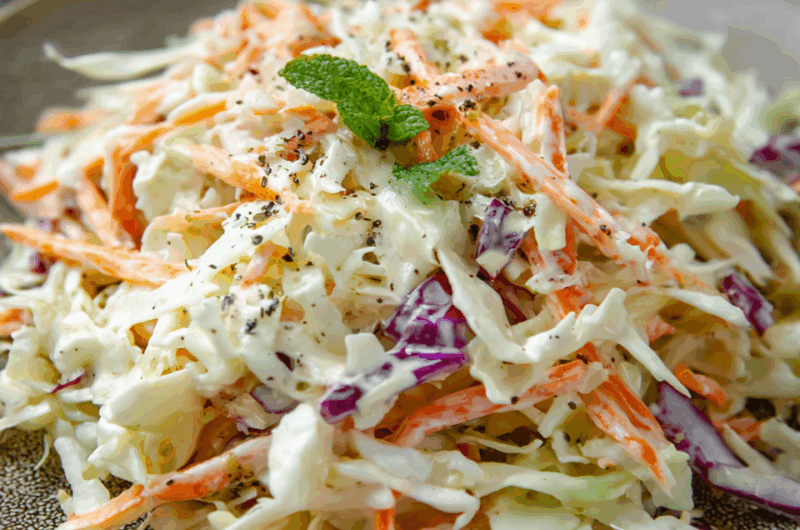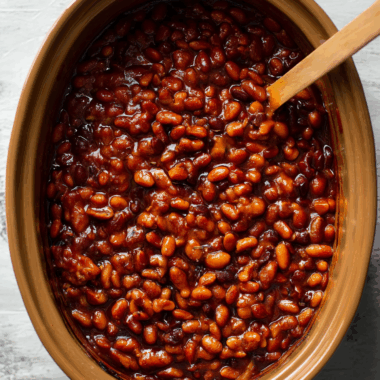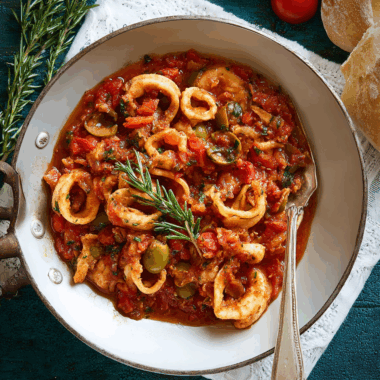Coleslaw is a timeless side dish that brings together fresh, crunchy vegetables with a rich and tangy dressing. This classic creamy version uses finely shredded cabbage and carrots, tossed in a smooth blend of mayonnaise, vinegar, sugar, and a hint of mustard for depth. The celery seed adds a subtle aromatic touch, but you can skip it if you prefer a cleaner flavor. Perfect for BBQs, fried chicken dinners, sandwiches, or as a fresh topping for pulled pork, this coleslaw is all about balance — crisp veggies meeting creamy tang. The longer it chills, the better the flavors marry, making it an ideal make-ahead dish for parties, picnics, or weekday meals. Serve it cold, and watch it disappear from the table!
Full recipe:
Ingredients:
-
1 medium green cabbage, finely shredded
-
2 large carrots, peeled and shredded
-
1/2 cup mayonnaise
-
2 tablespoons apple cider vinegar
-
2 tablespoons sugar
-
1 teaspoon Dijon mustard
-
1/2 teaspoon celery seed (optional)
-
Salt and freshly ground black pepper to taste
Directions:
-
In a large bowl, combine the shredded cabbage and carrots.
-
In a separate small bowl, whisk together mayonnaise, apple cider vinegar, sugar, Dijon mustard, and celery seed until smooth and creamy.
-
Pour the dressing over the cabbage mixture.
-
Toss gently until all the vegetables are evenly coated.
-
Season with salt and pepper to taste.
-
Cover and refrigerate for at least 1 hour before serving to allow flavors to blend.
Prep Time: 15 minutes | Cooking Time: 0 minutes | Total Time: 1 hour 15 minutes (including chilling)
Kcal: 180 kcal | Servings: 6 servings
The History and Origin of Coleslaw
Coleslaw has a rich culinary history that spans centuries. The name “coleslaw” comes from the Dutch term koolsla, which means “cabbage salad.” Dutch settlers brought this dish to America in the 18th century, and it quickly became a staple at gatherings, especially in the Southern United States. Traditionally, coleslaw was made with finely sliced cabbage, vinegar, oil, and seasonings, making it a fresh, easy-to-make accompaniment to heavy meats and fried foods.
Over time, mayonnaise was introduced to the recipe, adding a creamy richness that perfectly balanced the tang of vinegar. The creamy version became especially popular in the mid-20th century, cementing itself as the go-to side dish for BBQs, picnics, and family dinners. Today, coleslaw is enjoyed worldwide in many variations, from vinegar-based Carolina slaw to Asian-inspired sesame coleslaw, but the classic creamy variety remains a beloved favorite.
Why This Recipe Stands Out
What sets this particular coleslaw apart from others is the perfect balance between crunch, creaminess, and tangy-sweet flavor. The dressing is simple but refined — using mayonnaise for richness, apple cider vinegar for brightness, sugar for gentle sweetness, and Dijon mustard for depth. The optional celery seed adds a mild earthy note that ties everything together without overpowering the vegetables.
Unlike store-bought coleslaw, which can often be overly sweet or watery, this homemade version gives you complete control over flavor and texture. The cabbage stays crisp because it’s freshly shredded, and the dressing is whisked together just before combining, ensuring a fresh and vibrant taste every time.
Health Benefits of Coleslaw
Although creamy coleslaw might not be the first dish you think of when talking about nutrition, it actually offers some surprising health benefits — especially when made from scratch with fresh ingredients.
Cabbage is a nutrient powerhouse. It’s rich in vitamins C and K, supports healthy digestion thanks to its fiber content, and contains antioxidants that help protect the body against inflammation. Carrots add a boost of beta-carotene, which supports eye health and immune function.
By making coleslaw at home, you can also control the type and amount of mayonnaise you use. Opting for a lighter mayo or even a Greek yogurt blend can significantly reduce calories while still keeping the dressing creamy. You can also cut down on sugar or replace it with natural sweeteners like honey or maple syrup for a healthier twist.
Tips for Perfect Coleslaw Every Time
Making coleslaw seems straightforward, but a few small tips can make all the difference in taste and texture:
-
Shred your cabbage finely. Thin shreds not only look better but also absorb the dressing more evenly.
-
Salt the cabbage before dressing. For extra crispness, sprinkle a small amount of salt on the cabbage and let it sit for 10–15 minutes before rinsing and patting dry. This draws out excess moisture, preventing a watery salad.
-
Chill before serving. Allowing the coleslaw to sit in the fridge for at least an hour lets the flavors meld beautifully.
-
Balance the dressing. Taste the dressing before adding it to the cabbage. Adjust vinegar or sugar levels to suit your preference.
-
Use fresh ingredients. Crisp, just-cut vegetables make a huge difference in both flavor and presentation.
Pairing Ideas for Classic Creamy Coleslaw
This coleslaw’s versatility is one of its strongest features. It works beautifully alongside many dishes, such as:
-
BBQ meats like pulled pork, ribs, or grilled chicken.
-
Fried foods such as Southern fried chicken or crispy fish.
-
Sandwiches and burgers — add it inside for crunch and creaminess.
-
Tacos, especially fish or shrimp tacos, for a refreshing contrast.
-
Picnic platters with grilled vegetables, potato salad, and corn on the cob.
Its cool, creamy texture cuts through the richness of hearty or fried foods, providing a refreshing balance on the palate.
Make-Ahead and Storage Tips
Coleslaw is an excellent make-ahead dish, making it ideal for busy schedules or hosting events. You can prepare the shredded vegetables a day in advance and store them in an airtight container in the fridge. The dressing can also be made ahead of time and kept separately. Simply toss the vegetables and dressing together about an hour before serving to keep everything fresh and crunchy.
Leftover coleslaw should be stored in an airtight container in the refrigerator and is best consumed within 2–3 days. While it will still be safe to eat after that, the vegetables may lose their crispness.
Variations You Can Try
While this recipe is a classic, coleslaw is one of the most adaptable side dishes out there. Here are a few variations you might enjoy:
-
Vinegar-Based Slaw: Skip the mayonnaise and use a mixture of vinegar, olive oil, sugar, and seasonings for a lighter, tangier version.
-
Apple Coleslaw: Add thinly sliced apples for a sweet, fruity twist.
-
Asian Slaw: Use sesame oil, rice vinegar, soy sauce, and a sprinkle of sesame seeds.
-
Spicy Slaw: Add a pinch of cayenne pepper, diced jalapeños, or hot sauce to the dressing.
-
Herb-Infused Slaw: Mix in fresh dill, parsley, or cilantro for a burst of freshness.
These adaptations allow you to match the slaw to different cuisines or personal preferences.
Why Homemade Beats Store-Bought
Store-bought coleslaw may be convenient, but it often falls short in terms of freshness and flavor. Pre-packaged versions tend to be overly processed, loaded with preservatives, and lacking in crunch. The cabbage can become limp, and the dressing may be too sweet or overly thick.
Making coleslaw at home means you can:
-
Adjust sweetness and tang to your liking.
-
Ensure the vegetables are crisp and fresh.
-
Avoid unnecessary additives and preservatives.
-
Experiment with flavors and textures.
It’s not just about taste — homemade coleslaw also gives you the satisfaction of creating something fresh and wholesome for your family or guests.
Serving Coleslaw for Special Occasions
Coleslaw might be a humble side dish, but it can be dressed up for holidays and gatherings. For example, adding colorful purple cabbage alongside green cabbage makes the dish visually striking. Using a decorative serving bowl or garnishing with fresh herbs can elevate its presentation.
For large gatherings like family reunions, BBQs, or potlucks, coleslaw is a lifesaver because it’s budget-friendly, easy to prepare in bulk, and generally well-loved by guests of all ages. It’s also a safe bet for outdoor events because it pairs with almost any main course.
Nutritional Considerations and Adjustments
If you’re watching your calorie intake or following a specific diet, coleslaw is easy to adapt. Using a lighter mayonnaise or blending mayo with plain Greek yogurt cuts down fat while maintaining creaminess. Reducing sugar or using natural sweeteners lowers the carb content, and adding more vegetables like bell peppers or kale increases fiber and vitamins.
For those on a vegan diet, plant-based mayonnaise alternatives are widely available and work beautifully in this recipe. With a few tweaks, coleslaw can fit seamlessly into gluten-free, keto, or paleo diets.
Conclusion
Classic Creamy Coleslaw is more than just a side dish — it’s a refreshing, versatile, and nostalgic recipe that has earned its place at tables around the world. With its crisp vegetables, creamy tangy dressing, and endless adaptability, it’s no wonder this simple salad continues to be a favorite across generations. Whether served alongside smoky BBQ, tucked into a sandwich, or enjoyed on its own, this coleslaw delivers both comfort and freshness in every bite. Making it from scratch ensures the best flavor, texture, and nutritional benefits, giving you a dish that’s as wholesome as it is delicious.








